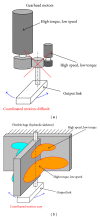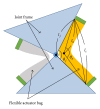Active joint mechanism driven by multiple actuators made of flexible bags: a proposal of dual structural actuator
- PMID: 24385868
- PMCID: PMC3872152
- DOI: 10.1155/2013/128916
Active joint mechanism driven by multiple actuators made of flexible bags: a proposal of dual structural actuator
Abstract
An actuator is required to change its speed and force depending on the situation. Using multiple actuators for one driving axis is one of the possible solutions; however, there is an associated problem of output power matching. This study proposes a new active joint mechanism using multiple actuators. Because the actuator is made of a flexible bag, it does not interfere with other actuators when it is depressurized. The proposed joint achieved coordinated motion of multiple actuators. This report also discusses a new actuator which has dual cylindrical structure. The cylinders are composed of flexible bags with different diameters. The joint torque is estimated based on the following factors: empirical formula for the flexible actuator torque, geometric relationship between the joint and the actuator, and the principle of virtual work. The prototype joint mechanism achieves coordinated motion of multiple actuators for one axis. With this motion, small inner actuator contributes high speed motion, whereas large outer actuator generates high torque. The performance of the prototype joint is examined by speed and torque measurements. The joint showed about 30% efficiency at 2.0 Nm load torque under 0.15 MPa air input.
Figures
















References
-
- Pierrot F, Reynaud C, Fournier A. DELTA. A simple and efficient parallel robot. Robotica. 1990;8:105–109.
-
- Kock S, Schumacher W. Parallel x-y manipulator with actuation redundancy for high-speed and active-stiffness applications. Proceedings of the IEEE International Conference on Robotics and Automation; May 1998; Leuven, Belgium. pp. 2295–2300.
-
- Collado J, Lozano R, Fantoni I. Control of convey-crane based on passivity. Proceedings of the American Control Conference; June 2000; pp. 1260–1264.
-
- Srnik J, Pfeiffer F. Dynamics of CVT chain drives. International Journal of Vehicle Design. 1999;22(1):54–72.
-
- Kobayashi D, Mabuchi Y, Katoh Y. A study on the torque capacity of a metal pushing V-belt for CVTs. SAE Technical Paper. 2010;(980822)
Publication types
MeSH terms
LinkOut - more resources
Full Text Sources
Other Literature Sources

